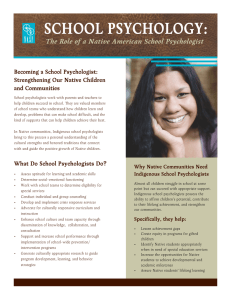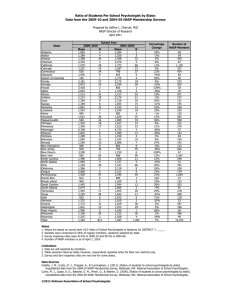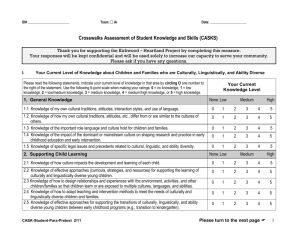Position Statement Recruitment of Culturally and Linguistically Diverse School Psychologists
advertisement
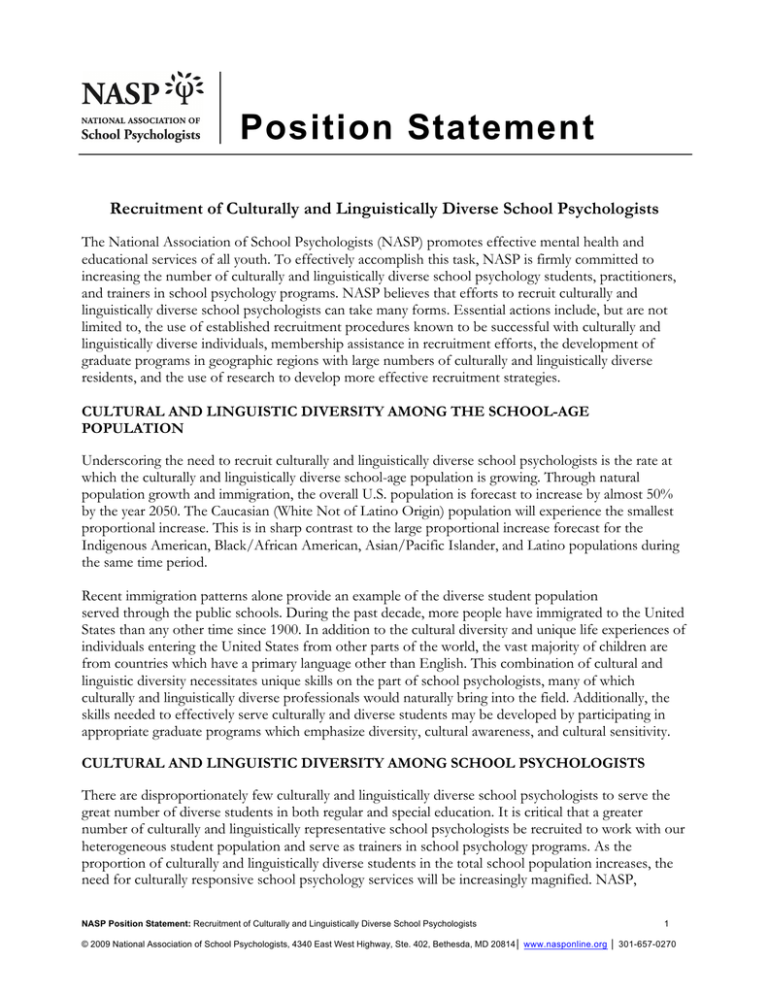
Position Statement Recruitment of Culturally and Linguistically Diverse School Psychologists The National Association of School Psychologists (NASP) promotes effective mental health and educational services of all youth. To effectively accomplish this task, NASP is firmly committed to increasing the number of culturally and linguistically diverse school psychology students, practitioners, and trainers in school psychology programs. NASP believes that efforts to recruit culturally and linguistically diverse school psychologists can take many forms. Essential actions include, but are not limited to, the use of established recruitment procedures known to be successful with culturally and linguistically diverse individuals, membership assistance in recruitment efforts, the development of graduate programs in geographic regions with large numbers of culturally and linguistically diverse residents, and the use of research to develop more effective recruitment strategies. CULTURAL AND LINGUISTIC DIVERSITY AMONG THE SCHOOL-AGE POPULATION Underscoring the need to recruit culturally and linguistically diverse school psychologists is the rate at which the culturally and linguistically diverse school-age population is growing. Through natural population growth and immigration, the overall U.S. population is forecast to increase by almost 50% by the year 2050. The Caucasian (White Not of Latino Origin) population will experience the smallest proportional increase. This is in sharp contrast to the large proportional increase forecast for the Indigenous American, Black/African American, Asian/Pacific Islander, and Latino populations during the same time period. Recent immigration patterns alone provide an example of the diverse student population served through the public schools. During the past decade, more people have immigrated to the United States than any other time since 1900. In addition to the cultural diversity and unique life experiences of individuals entering the United States from other parts of the world, the vast majority of children are from countries which have a primary language other than English. This combination of cultural and linguistic diversity necessitates unique skills on the part of school psychologists, many of which culturally and linguistically diverse professionals would naturally bring into the field. Additionally, the skills needed to effectively serve culturally and diverse students may be developed by participating in appropriate graduate programs which emphasize diversity, cultural awareness, and cultural sensitivity. CULTURAL AND LINGUISTIC DIVERSITY AMONG SCHOOL PSYCHOLOGISTS There are disproportionately few culturally and linguistically diverse school psychologists to serve the great number of diverse students in both regular and special education. It is critical that a greater number of culturally and linguistically representative school psychologists be recruited to work with our heterogeneous student population and serve as trainers in school psychology programs. As the proportion of culturally and linguistically diverse students in the total school population increases, the need for culturally responsive school psychology services will be increasingly magnified. NASP, NASP Position Statement: Recruitment of Culturally and Linguistically Diverse School Psychologists 1 © 2009 National Association of School Psychologists, 4340 East West Highway, Ste. 402, Bethesda, MD 20814│ www.nasponline.org │ 301-657-0270 therefore, is committed to the recruitment of members from culturally and linguistically diverse groups and recommends the implementation of the strategies below. STRATEGIES FOR INCREASING MINORITY RECRUITMENT NASP advocates for the use of established recruitment procedures related to enrollment in graduate programs that are known to be successful, including: • • • • Multifaceted admission standards. Multifaceted admission standards provide greater opportunity for recognizing the various strengths that diverse individuals contribute to school psychology programs. Additional admissions strategies may include those that recognize various professional and life experiences prior to the pursuit of an advanced degree as a complement to the entrance examination requirements and/or grade point average requirements. Such multifaceted strategies are preferable to standards that focus on test scores from measures shown to be culturally biased. Flexible training options. Graduate programs may meet the needs of working students by offering part-time educational opportunities for some of the student's graduate education. In addition, some key coursework may be offered in the evenings or during the summer. This may serve to encourage individuals who would be qualified candidates, such as teachers currently working in the schools, to enter the field of school psychology. Financial support. Comprehensive financial support may take the form of waived or reduced application fees, the availability of noncontingent financial aid (including grants and fellowships) in addition to loans, and the use of scholarships for eligible culturally and linguistically diverse students (e.g., NASP Minority Scholarship and state association scholarships). Active outreach efforts. Outreach efforts targeting culturally and linguistically diverse populations may include the use of brochures addressing the concerns of culturally and linguistically diverse groups, graduate/career fairs and expos at ethnically diverse institutions of higher education (e.g., historically Black colleges and universities), media advertisements, personal contacts, and the use of current and past student ambassadors to present on the field of school psychology to diverse student organizations (e.g., African American, Latino, Indigenous American, and Asian Student Unions; undergraduate multicultural psychology associations, etc.). NASP encourages its membership to assist school psychology graduate programs in recruiting members of culturally and linguistically diverse groups into the profession through: • • • Mentoring. NASP members may serve as mentors for students interested in pursuing careers in education and psychology. Through this grassroots effort, many talented high school and undergraduate students may become informed about the profession of school psychology and the various duties and requirements involved. Nominating. NASP members are encouraged to nominate talented students to regional and national school psychology graduate programs. Advocating. NASP members may serve as advocates for talented students throughout the application and admission process. This may be accomplished through letters of recommendation, a willingness to provide information regarding various application procedures, and ongoing support and encouragement. NASP supports the development of school psychology graduate programs in geographic regions with large numbers of culturally and linguistically diverse residents. In order to increase the total recruitment pool and provide educational opportunities for a greater number of individuals, cities and states with a NASP Position Statement: Recruitment of Culturally and Linguistically Diverse School Psychologists 2 © 2009 National Association of School Psychologists, 4340 East West Highway, Ste. 402, Bethesda, MD 20814│ www.nasponline.org │ 301-657-0270 very diverse population are encouraged to develop graduate programs that focus on the recruitment and training of culturally and linguistically diverse students. One barrier that prevents culturally and linguistically diverse members from entering school psychology is a lack of awareness about the profession. Active recruitment across school psychology departments and NASP members would help to promote school psychology within diverse communities. All graduate programs are encouraged to actively recruit and increase awareness among high school students and undergraduate students from freshmen to seniors. Graduate programs are encouraged to diversify admission committees. All attempts should be made to ensure that culturally and linguistically diverse participants, including current students, are included on admission panels. NASP also encourages school psychology graduate programs to conduct research and develop the most appropriate strategies to recruit, train, and graduate greater numbers of culturally and linguistically diverse individuals from their programs. SUMMARY NASP is firmly committed to the recruitment of greater numbers of culturally and linguistically diverse individuals into the profession of school psychology. Culturally and linguistically diverse school psychologists are needed to serve the mental health and educational interests of all youth and to train the practitioners of tomorrow. NASP believes that most effective strategies for recruiting diverse faculty and students are those that remove barriers from the path of prospective students and involve both association members and school psychology graduate institutions. REFERENCES Helms, J. E. (2006). Fairness is not validity or cultural bias in racial-group assessment: A quantitative perspective. American Psychologist, 61, 845–859. Malgady, R. G. (1996). The question of cultural bias in assessment and diagnosis of ethnic minority clients: Let’s reject the null hypothesis. Professional Psychology: Research and Practice, 27, 73–77. Suzuki, L. A., & Valencia, R. R. (1997). Race-ethnicity and measured intelligence: Educational implications. American Psychologist, 52, 1103–1114. Adopted by the NASP Delegate Assembly on July 17, 2009. Please cite this document as: National Association of School Psychologists. (2009). Recruitment of Culturally and Linguistically Diverse School Psychologists (Position Statement). Bethesda, MD: Author. NASP Position Statement: Recruitment of Culturally and Linguistically Diverse School Psychologists 3 © 2009 National Association of School Psychologists, 4340 East West Highway, Ste. 402, Bethesda, MD 20814│ www.nasponline.org │ 301-657-0270

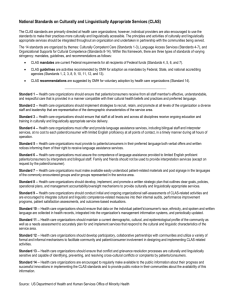
![[Today’s Date] [Your Supervisor’s First Name] [Your School or District’s Name]](http://s2.studylib.net/store/data/010451343_1-ed5410b4013e6d3fbc1a9bbd91a926a9-300x300.png)
